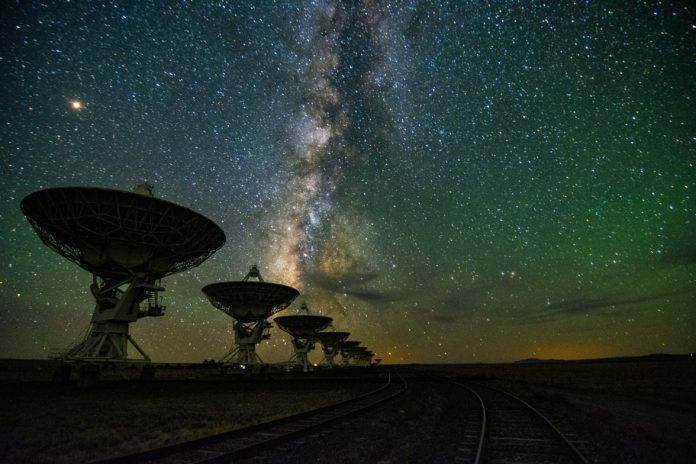For a brief moment after a massive star begins to die, it is the brightest object in the galaxy, releasing more energy in 10 seconds than the Sun will in its entire lifetime. This immense amount of energy comes in the form of high-frequency gamma rays and, fittingly, is known as a “gamma ray burst” — the “last words” of dying stars that puzzled astronomers for years after their discovery.
Today, astronomers believe that most gamma ray bursts are released during the explosions triggered by the deaths of massive stars, and originate in distant galaxies billions of light-years from Earth.
But while millions of stars die every day, stars massive enough to result in gamma ray bursts are rare — and despite momentarily being the brightest objects in the night sky, detecting these gamma ray bursts is more difficult than you might think.
During the explosive stellar death, two concentrated jets of radiation are emitted on opposite sides of the collapsing star that, if fortuitously pointed towards the Earth, appear to astronomers as extremely bright flashes of gamma rays: a gamma ray burst. But the chances of these narrow jets aligning perfectly with the Earth are slim, and most gamma ray bursts in the Universe likely go undetected.
Explosions this powerful do leave evidence behind, however. When a gamma ray burst shoots through the cloud of gas that once surrounded the original star, it creates a massive shock wave or “sonic boom” that heats up the gas and causes it to radiate radio emission in all directions, and not just the narrow path of the gamma ray burst itself.
Now, a team of astronomers has used this phenomenon to detect the sonic boom from a powerful gamma ray burst deep in outer space, despite seeing no trace of the original gamma ray burst itself.
The study, led by Casey Law from the University of California, Berkley and co-authored by Bryan Gaensler, director of the Dunlap Institute for Astronomy & Astrophysics at the University of Toronto, was published in The Astrophysical Journal Letters.
Massive star’s last words leave lasting impression
The “afterglow” emission from a dying massive star’s sonic boom lasts much longer than its fleeting gamma ray bursts, and this has proved to be the best tool astronomers have for learning more about stellar explosions. But the afterglow emission is much fainter than the gamma ray burst from which it originates, and studying it requires many years’ worth of observations.
Luckily, this is exactly what Law, Gaensler, and their collaborators had access to with the Karl G. Jansky Very Large Array, an observatory in New Mexico made up of twenty-seven radio telescopes that have been surveying the sky for more than two decades.
While comparing sources of radio emission in archival observations over the past several decades to data from the ongoing Very Large Array Sky Survey (VLASS), the team made a startling discovery: one particular source was no longer there. By analyzing years of observations of that same location in the sky, they concluded that the source had faded by a factor of 50 over two decades.
A change this significant was peculiar when compared to other radio sources in the survey. Active galactic nuclei, for example, can vary on short timescales but take more than a million years to fade away.
“Sources should not fade by a factor of 50 like this thing had,” says Gaensler, co-author on the paper. “Straightaway this tells you that this is something unusual and something that hadn’t been seen before.”
Hearing the thunder without seeing the lightning
This strange fading, combined with the fact that the source originated from a “dwarf galaxy”, which is exactly where most gamma ray bursts are detected, led the team to believe that there was more to this particular source than they’d anticipated — perhaps it was the fading afterglow of a gamma ray burst from many years ago.
Yet a search through catalogues of observed gamma ray bursts left the team empty-handed. Despite the fading radio emission being exactly what they’d expect from a gamma ray burst’s sonic boom, there was no trace of the associated gamma ray burst in the night sky.
They’d discovered what astronomers interested in gamma ray bursts had spent years searching for: the “orphan afterglow” from a gamma ray burst pointed away from the Earth and completely hidden from our view.
“It’s a bit like hearing the thunder but never having any lightning,” Gaensler explains.
By studying this orphan afterglow, Gaensler and his collaborators can learn more about the gamma ray bursts themselves.
With large surveys like the VLASS continuously observing the sky over the next few years, discoveries like this are likely to become much more common. Rather than having to wait for a rare gamma ray burst to align itself with the Earth, astronomers can search instead for the fading orphan afterglows from gamma ray bursts pointed in any direction. And they now have decades of surveys to compare with their current observations.
“This new survey we’ve done, 23 years after the first one, should be an absolute gold mine for finding other objects just like this,” says Gaensler.
“We’ve found one, and now we’re on the hunt for more.”









































